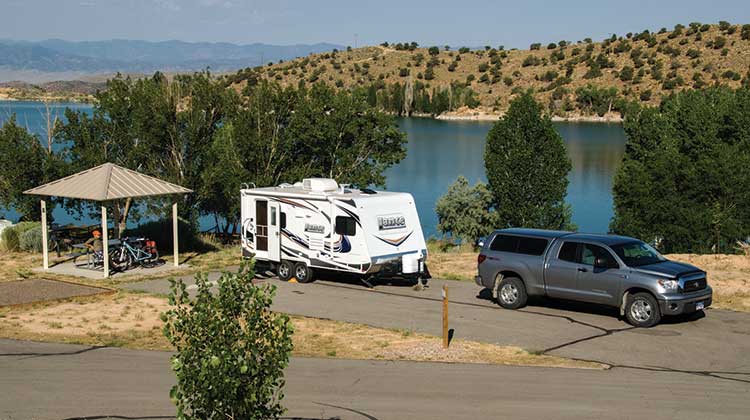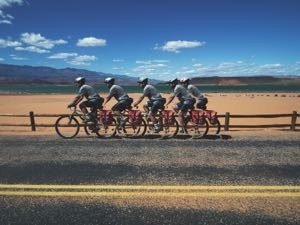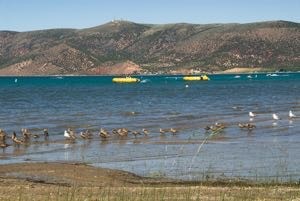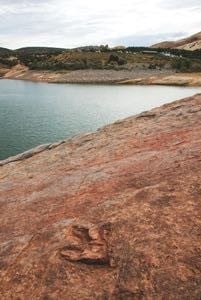
Photo Credit: Donna Ikenberry
As most RVers know, Utah has many beautiful destinations. Not only does the state have five national parks and six national monuments worthy of a visit, but also 43 excellent state parks.
In 1999, while working on my book, Camping Utah, my husband, Mike, and I traveled more than 8,000 miles in Utah checking out all of its 300-plus public campgrounds, including all of the state parks. Last summer my book was up for revision, so we traveled back to some of our favorite campgrounds to hike more trails, ride more single track on our mountain bikes and do some kayaking at various lakes.
During our most recent visit, I found that more than a dozen Utah state parks now offer full-hookup campground sites. I have chosen five of them to highlight here—Bear Lake, Palisade, Red Fleet, Sand Hollow and Wasatch Mountain. However, the remaining full-hookup state parks—Deer Creek, East Canyon, Huntington, Jordanelle, Kodachrome, Starvation, Steinaker and Williard Bay—are no less worthy of a visit.
Sand Hollow State Park

Mountain bikers ride around the reservoir at Sand Hollow State Park. Photo Credit: Donna Ikenberry
Utah’s Sand Hollow State Park is the most southern of the state parks and one of the newest. Opened in 2003, the park is very popular, according to one ranger, because it has so much to offer. Although visitors get the feeling of being away from it all, the park is not that far from the towns of St. George and Hurricane, where you can get a good meal at a local restaurant, shop to your heart’s content, or see a movie.
Sand Hollow has lovely views of surrounding mountains, a boat ramp and water for boating, kayaking, paddle boarding, jet skiing and swimming. Just beware of swimmer’s itch—a tingling, burning, or itching of the skin due to a microscopic parasite found in shallow water.
We spent our first day mountain biking around the park. On the second day, we kayaked Sand Hollow Reservoir and paddled among a number of eared and western grebes. On our third day, we explored the surrounding area, enjoying a visit to the St. George Dinosaur Discovery Site on a particularly hot day. In the air-conditioned museum, we marveled at the well-preserved dinosaur tracks and thoroughly enjoyed what some paleontologists describe as one of the 10 best dinosaur track sites in the world. The only activity we didn’t participate in while at the state park was OHV riding on the sand dunes, but that’s because we don’t own an ATV.
Two campgrounds suit everyone, from those who want only a basic campsite to those who want it all. The West Campground has spacious sites, some with views of the reservoir, and full hookups. ATVs are not allowed in the campground, except on a trailer. ATVs are allowed at the Sandpit Campground, which is near the OHV staging area at the dunes. This campground has basic sites with picnic tables and fire rings, and six sites with electricity.
If you really like to get away from it all, Sand Hollow offers primitive beach camping. Although there is no camping charge, you pay a day-use fee. Please note: The state park will not tow you out if you get stuck in the sand, so beware. Enter only where there are signs beckoning you to try beach camping. Some side roads were so sandy during our visit that we ended up walking our bikes.
Palisade State Park
Palisade State Park is a popular place for young and old alike. There are four campgrounds, three of which (Arapeen, Pioneer and Sanpitch) have been around for a long time. The three have lots of big cottonwood trees for shade and are the closest campgrounds to the shores of Palisade Lake.
We camped at Wakara, a new campground with spacious, full-hookup sites and nice views, located on a slope above the lake. We thoroughly enjoyed our stay because there is so much to see and do. In addition to kayaking on the lake, and just plain relaxing, we hiked the trail around the lake and mountain biked up nearby Six-Mile Canyon. ATVers will want to explore the same canyon, which eventually leads high up into the mountains at Skyline Drive. Golfers will no doubt enjoy the 18-hole golf course, a driving range and one of the best putting greens in the state. If you don’t feel like cooking, there’s also a restaurant at the clubhouse.
Wasatch Mountain State Park
Wasatch Mountain State Park is a large park—nearly 22,000 acres—with much to offer. Set aside by the state in 1961, the park was host of the 2002 Olympic Winter Games at Soldier Hollow. Open year-round, Soldier Hollow offers hiking, mountain biking and equestrian use in summer and snowshoeing and cross-country skiing in winter.
This state park literally offers something for everyone. One morning we mountain biked the Dutch Hollow section of the park and came across a woman horseback riding, a man jogging, a young family with children mountain biking, and more young people biking as well. After some strenuous riding, we made a visit to the 1878 Huber Grove farmhouse, which was open for a few hours so interested visitors could peer inside. The Huber family lived in the home until the property became part of the state park in the early 1960s. The ranch house and creamery have been restored, so be sure to have a look. And on September weekends don’t miss the apple harvest at Huber Grove.
Bear Lake State Park

Birds and people enjoy the water at Bear Lake State Park. Photo Credit: Donna Ikenberry
In the northern region of the state, Bear Lake State Park is a definite must-visit. We camped on the southern edge of the park at Birch Creek, a new campground with full hookups and paved, flat sites, and were amazed at the beauty before us.
Bear Lake is big, certainly too big for the two of us to kayak around. It is 20 miles long and eight miles wide, so instead of kayaking around the lake, we drove around. We made our way via paved roads and entered Idaho in the process as the upper half of the lake crosses the state line. As we circled the lake, amazed by the huge American white pelicans we observed, we wondered about the lake’s beautiful, blue color. Later we found that it is the result of minerals suspended in the waters.
Another day, we drove to Fossil Butte National Monument in Wyoming. Mike and I are always interested in the national park system, so the 40-plus-mile drive to Fossil Butte was one we couldn’t pass up. We hiked and learned about the fossils found there. Called ?“America’s Aquarium in Stone,” the 50-million-year-old lake bed holds some of the world’s best-preserved fossils.
While at Bear Lake, we kayaked the southern end of the lake and watching marbled godwits and American avocets in the shallows. Other visitors fished, played in the water and zoomed by in their powerboats. We also rode our bikes around the various campgrounds and one day we took a scenic drive through beautiful Logan Canyon, which is nearby.
En route to Logan Canyon, we passed through the small town of Garden City, where locals said we should stop and have one of the city’s famous raspberry milkshakes. We each ordered a milkshake and enjoyed every swallow. If you are in town two days prior to the first Saturday in August, you may thrill to the start of Bear Lake Raspberry Days, an annual, three-day event complete with parade, craft fair, entertainment, a pageant, dances, fireworks on the beach and more.
Red Fleet State Park

Dinosaur tracks can be found at Red Fleet State Park. Photo Credit: Donna Ikenberry
Upon visiting Red Fleet State Park, in the northeast corner of Utah, I couldn’t help but love all the spectacular sandstone cliffs and the gorgeous setting. Named for the sandstone formations that resemble a fleet of ships, Red Fleet has only one negative aspect—parking-lot style camping, which I usually abhor. But we stayed several nights and thoroughly enjoyed this true gem due to the fact that we could hike to—even kayak to—some 200-millon-year-old dinosaur tracks.
We were also close enough to drive to the Dinosaur National Monument to see lots of dinosaur bones. In addition, we drove to the McConkie Ranch, 22 miles southwest of the park, and gazed in awe at the hundreds of petroglyphs (figures chipped into rock) and some pictographs (figures painted onto the rock) found along a one-mile stretch of the 200-foot-high sandstone canyon wall at this private ranch.
The Dry Canyon petroglyphs at McConkie Ranch, 10 miles north of Vernal, are world-renowned. The figures represent the Fremont culture, which lived in this region from the year 1 to 1200. Trails lead to the rock art, which you must not touch.
Visit Utah’s state parks and you’ll see all sorts of unique wonders, enjoy all kinds of water sports, and find plenty of trails to hike and bike, as well as scenic roads to drive. And when you camp, you can have full hookups as well!
Donna Ikenberry is a writer and photographer who lives in South Fork, Colorado. The new edition of her book, “Camping Utah,” is available at amazon.com and other booksellers.

Very interesting article, interested about the atv areas, are there plenty in Utah